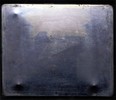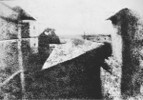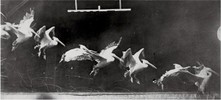Over the course of the semester, students are required to submit 3 visual analysis papers of 1,200 words each. Using visual and formal analysis as well as context discussed in readings and in class to explore the meaning of one or a pair of images. Students have the option of writing about the materials presented in different weeks, as detailed below.
Paris Photos
Write about one of the following two photos, or compare the two. The first is a black and white photo by Brassaï (Gyula Halasz) of the Pont Neuf in Paris, published in the photo book Paris by Night in 1932. The second is an anonymous recent color photo.
- Brassaï: Black and White Photo of Pont Neuf
Niépce Photos
Photo by Nicéphore Niépce, "View from the Window at Le Gras." 1826 or 1827. Look at both copies of the photo - if you like, you may compare the two (even though they are technically the 'same' photo):
Portraits
Write about either photo - or compare the two. The first is from the nineteenth century professional photographer, Mathew Brady. The second is an amateur photographer c. 1967.
Harcourt Photos
Compare the two photos:
- Brigitte Bardot (c. 1962)
- Jean Renoir (from the 1980s)
Surrealist Photos
Write about one of these two photos - or compare them:
- Umbo (Otto Umbehr), "Mystery of the Street," 1928
- Man Ray, "Le Violon d'Ingres," 1924
Street Photography
Write about the following photograph:
- Jon Rafman, "Rue des Poissonniers, Paris, France," 2009
Research & Investigation
Write about one of the two photographs, or compare them:
Tourism and Travel
Write about one of the two photographs, or compare them. Think this week about function as well as meaning.
Photojournalism
Write about the following photograph:
- Henri Cartier-Bresson, "Behind the Gare St. Lazare," Paris, 1932
Humanistic Photography
Write about either photo - or compare the two:
- Sabine Weiss, "Cartes Postales, Tour Eiffel," 1955
- Robert Doisneau, "The Kiss at the Hotel de Ville," 1950
War Photography
Write about one of the two photographs or compare them. Think this week about the history and function of war photography.
- Jeff Wall, "Dead Troops Talk," 1992 (more info about this photo)
- Lalage Snow, "Edens beyond the razor wire"
Mohammad Kabir, aged 105, Darulaman Palace Garden, September 2012:
I was 16 when I first started working here with my father in the palace gardens. They were beautiful. The king brought different flowers and trees from Europe and when the palace was being built there were elephants and donkeys to move all the heavy trees. The king was a good man and I remember those days happily. It makes me sad to see this palace in ruins, ruins like my country.
Now I work on the government vegetable garden for the Afghan National Army based here. I built this garden in the courtyard a few months ago just for fun. I feel like the plants have given me energy. I feel younger and more powerful and think that my hair is losing the white bits. I don't think this garden will last long, it will probably be destroyed. But everything you see growing here is from Paradise and I feel like I'm in Paradise when I'm here. I'm a poor man and sometimes there isn't enough to eat but gardening feeds you in a different way. The soldiers always say they like the greenery as it reminds them of peace. Who doesn't like that?








![The writing translates: Algerian types. Moorish woman. Handwritten: "I am sending you a package for pickup at the railway station. The babies are doing well; they have just walked by the beach. I shall write you shortly at greater length. Warm kisses to you all. [signed:] Martha." Postcard of a jailed bare-chested woman posing with a tambourine above her head.](/courses/global-studies-and-languages/21g-049-french-photography-fall-2014/assignments/visual-analysis-papers/tourism-and-travel/thumb_8.Tourism_Postcard-cropped_.jpg)
